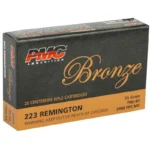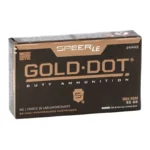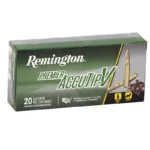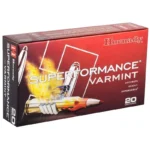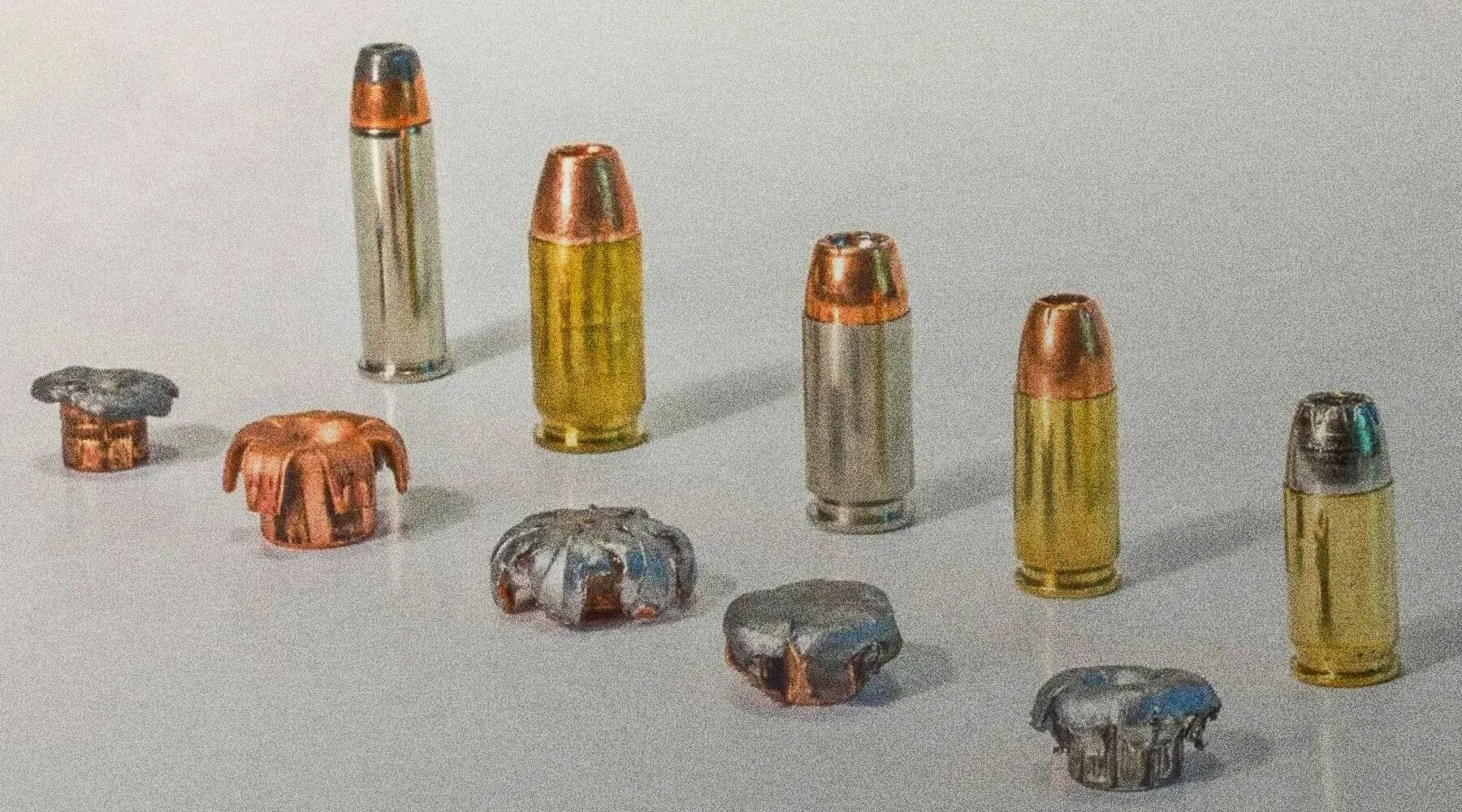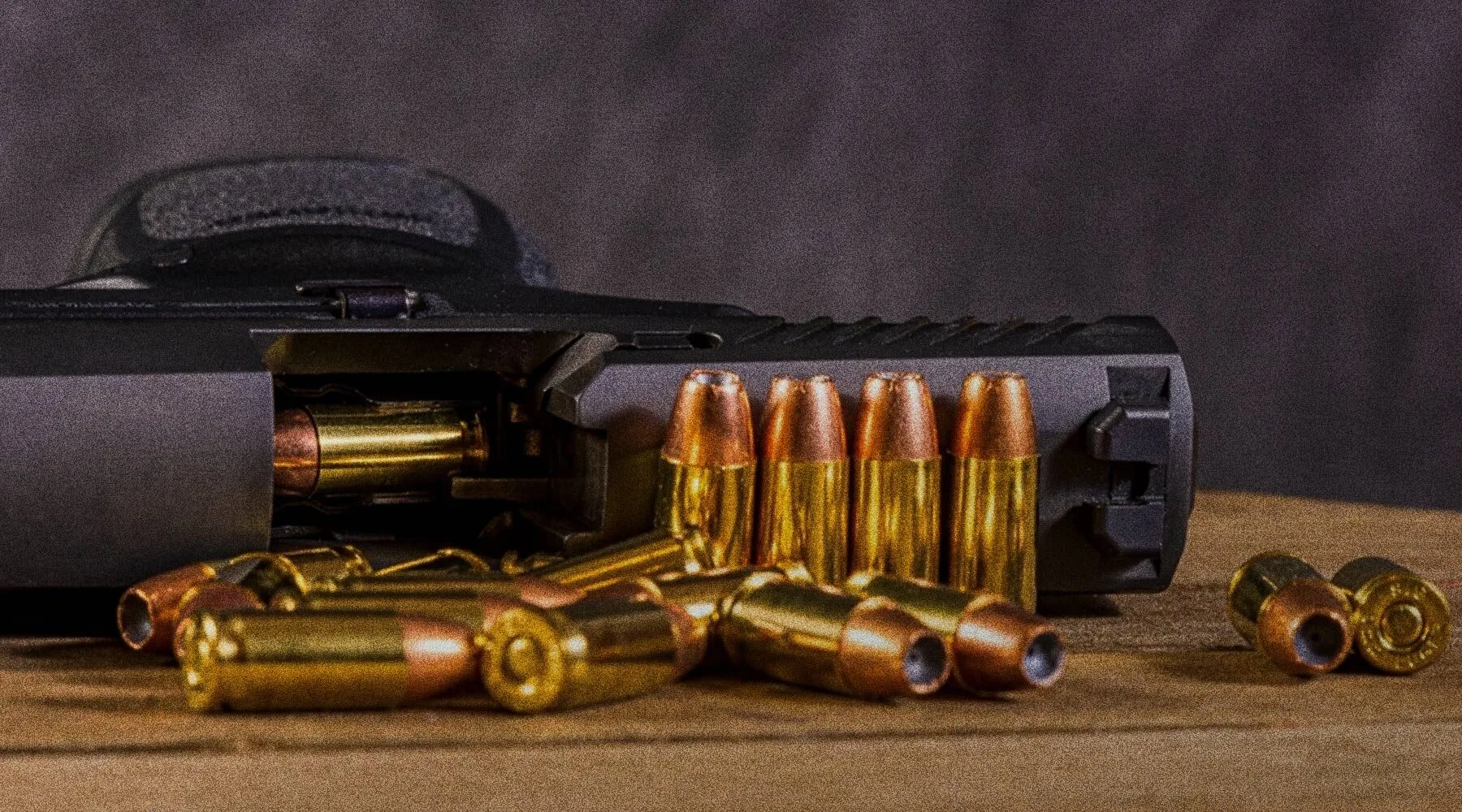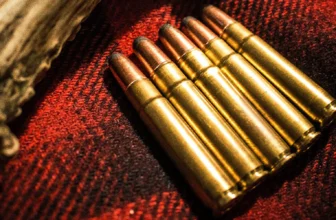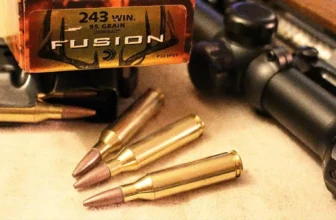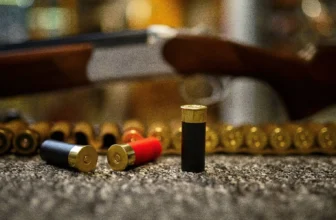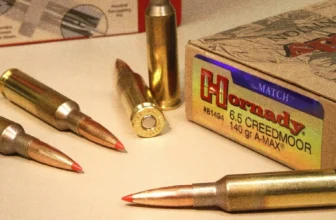Whether you’re here to learn more about the ballistics, check out use cases for each caliber, or just find quick solutions for coyote & varmint hunters. We’ve compiled the research for you here.
Don’t have the time to scroll? Read the shortest summary ever, here.
Choose .204 Ruger when you want the flattest trajectory and minimal recoil for varmint work; choose .223 Remington for broader versatility, heavier bullets, and cheaper ammo with more certain availability.
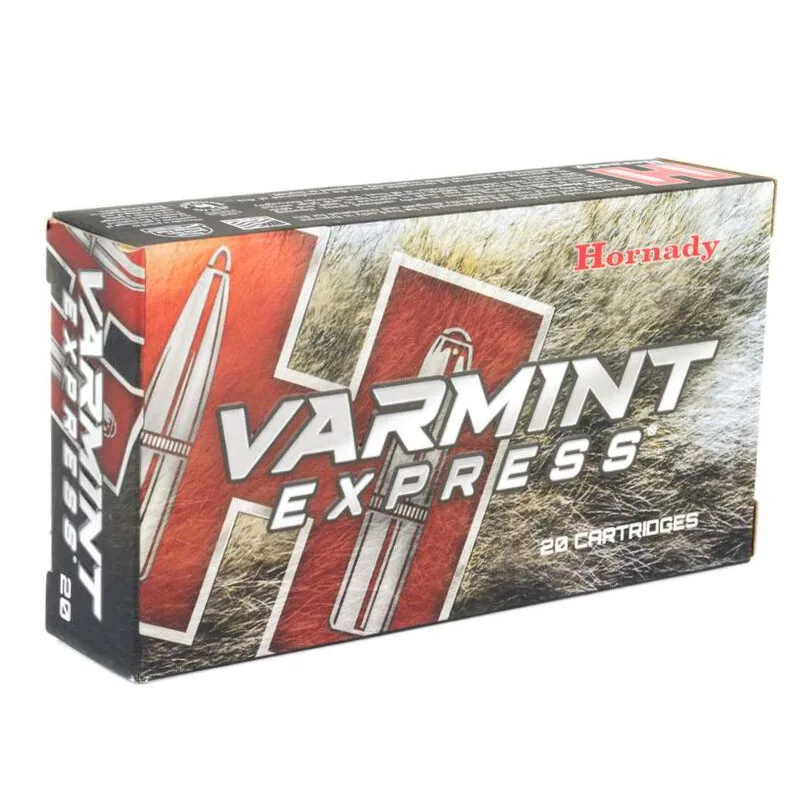
Hornady
Extremely rapid expansion, very flat trajectory for its weight
Muzzle Velocity 3240 fps
Muzzle Energy 1282 ft. lbs
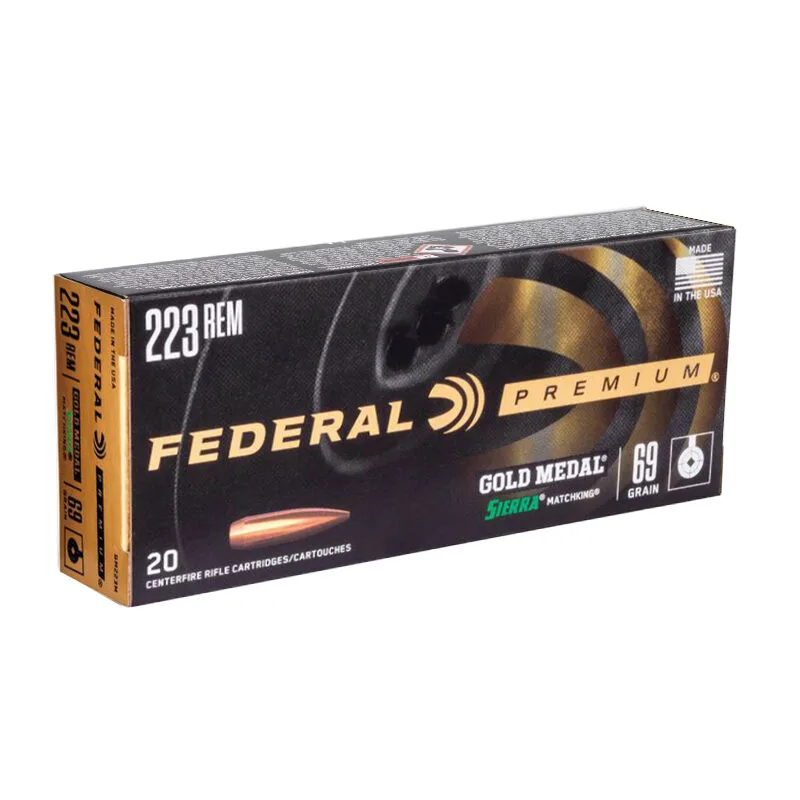
Muzzle Velocity 2950 fps
Muzzle Energy 1333 ft. lbs
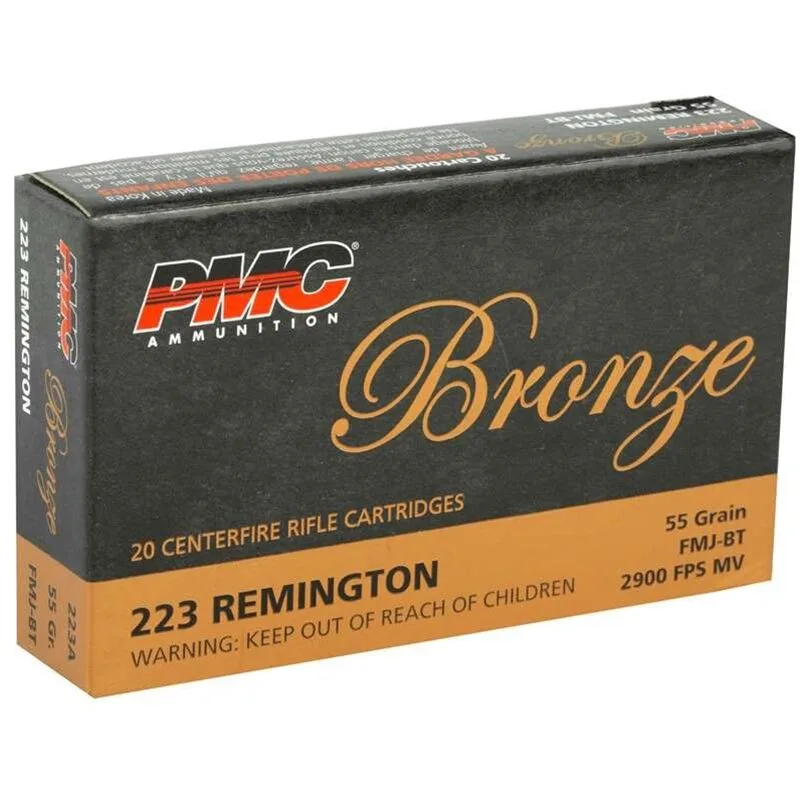
PMC
Muzzle Velocity 2900 fps
Muzzle Energy 1250 ft. lbs
Quick Facts (204 Ruger vs 223 Remington At-A-Glance)
| .204 Ruger | .223 Remington | |
|---|---|---|
| Year Introduced | 2004; introduced as a collaboration between Ruger & Hornady for a high-velocity varmint round | 1962; became the civilian counterpart of the 5.56/AR-platform family |
| Common Bullet Weights | Common factory offerings include 24, 32, 40 gr | Common factory loads include 55–62 gr.; heavier 69–77 gr. for match/hunting |
| Typical Uses | Varmint & predator work (mostly prairie dogs, ground squirrels, coyotes at range), bench/precision small-game shooting | Plinking, target & match shooting, and (with proper bullets in the allotted spaces) small-to-medium game |
| Recoil (typical 7.5–8 lb rifle) | Very light, typically low ft-lbs recoil (approx. 3–6 ft-lbs, load dependent) | Light but higher than .204 (approx. 6–10 ft-lbs, load dependent) |
| Effective Range For Hunting | Approx. 200–400 yards for ethical coyote/varmint shots | For varmint/coyote about 100–400 yards should do, depending on bullet weight; heavier bullets retain more energy past 300 yds |
| Barrel Twist (typical factory) | Varies by maker; many factory barrels favor faster twists suited to lighter .204 bullets. Approx. around 1:12-1:9 depending on bullet weight. Check manufacturer specs for exact twist. | Common factory twists vary by intended use. Typical modern barrels often fall in the 1:7–1:12 range depending on heavy vs light bullets. Check the manufacturer specs. |
| Platform Compatibility | Bolt-action varmint rifles and dedicated .204 chamberings from several manufacturers; popular among custom/precision builds. | Widely available across AR-platforms, bolt actions, and semi-autos with the highest rifle & ammo availability of the two. |
Other Relevant Reads:
Key 204 Ruger vs 223 Remington Specs
| Cartridge | Bullet Diameter | Case Length | Overall Length (OAL) | SAAMI Max Avg Pressure | Case Capacity (approx.) | Rim/Base Diameter | Primer | Case Type |
|---|---|---|---|---|---|---|---|---|
| .204 Ruger | 0.204 in (5.2 mm) | 1.85 in | 2.26 in | 57,000 psi | 34–35 gr H₂O | 0.378 in | Small Rifle | Rimless, bottleneck |
| .223 Remington | 0.224 in (5.7 mm) | 1.76 in | 2.26 in | 55,000 psi | 28–30 gr H₂O | 0.378 in | Small Rifle | Rimless, bottleneck |
So, let’s talk about this table…
Both the .204 Ruger and .223 Remington are short-action, rimless, bottleneck cartridges that share the same 0.378-inch rim/base diameter. This means they’ll function in similar bolt faces and magazine setups without the need for modification.
The .204 Ruger is essentially a necked-down .222 Remington Magnum case, optimized to fire much lighter .20 caliber bullets at extremely high velocities. That gives it a flatter trajectory and less recoil, making it superb for varmint and predator hunting at distances.
The .223 Remington, on the other hand, fires heavier .224 caliber bullets and has slightly lower maximum pressure, but greater case capacity flexibility for heavier projectiles. It’s more versatile overall, used in AR-platform rifles, hunting, competition, and even defensive roles. But you probably already knew that…
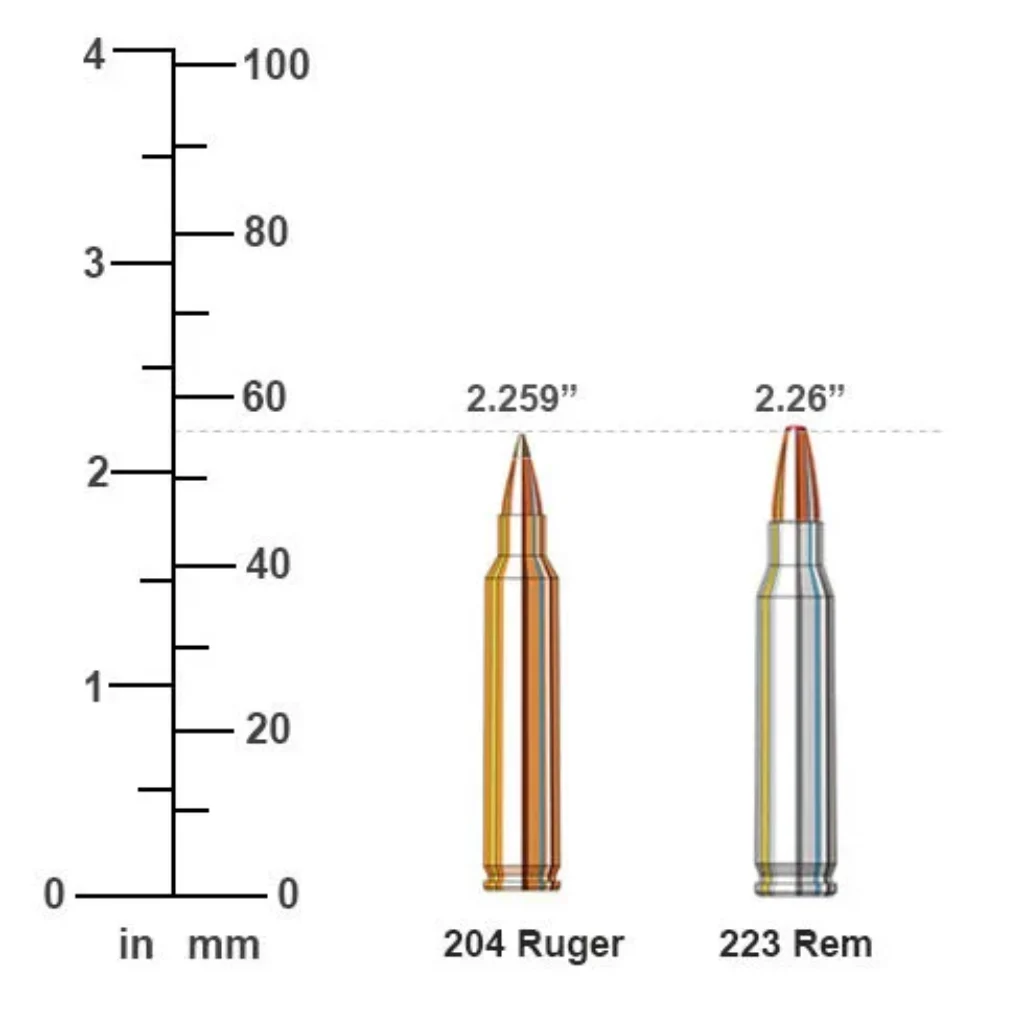
The .204 Ruger offers flatter shooting and lighter recoil, while the .223 Remington offers greater bullet variety, energy, and versatility. Determining which one is “better” depends on you. If you’re out shooting long-range at varmint and need the precision, go for 204. If you don’t have much of a “purpose” and need the versatility, the 223 is always the answer.
204 Ruger vs 223 Remington: Comparison and Use-Cases
| Cartridge | Load (Example) | Bullet Type | Bullet Weight | Muzzle Velocity | Muzzle Energy | Typical Use |
|---|---|---|---|---|---|---|
| .204 Ruger | Hornady Superformance 32 gr V-MAX | Thin-jacketed varmint | 32 gr | 4225 fps | 1280 ft-lbs | Prairie dogs, ground squirrels, coyotes; extremely flat-shooting varmint load |
| .204 Ruger | Federal Premium V-Shok 40 gr | Nosler Ballistic Tip | 40 gr | 3650 fps | 1183 ft. lbs | Long-range varmint and predator hunting; ideal for coyotes, foxes, and similar small game |
| .223 Remington | Hornady Varmint Express 55 gr V-MAX | Thin-jacketed varmint | 55 gr | 3240 fps | 1280 ft-lbs | Coyotes, varmints; versatile AR and bolt-gun hunting load |
| .223 Remington | Federal Premium 69 gr Sierra MatchKing BTHP | Match/OTM | 69 gr | 2950 fps | 1330 ft-lbs | Precision/match shooting; retains energy & resists wind better than light varmint loads |
| .223 Remington | Remington Express 62 gr Core-Lokt SP | Soft point hunting | 62 gr | 3100 fps | 1320 ft-lbs | Predators & small-to-medium game where legal; controlled expansion |
Pro tip on barrel lengths for 204 vs 223:
- .204 Ruger velocities are often listed based on 24″ test barrels. In shorter 20″ hunting rifles, you should realistically expect 100–150 fps less than the box states.
- .223 Remington also publishes speeds from 24″ test barrels. Compact AR-15s or 16–20″ bolt rifles usually run 100–200 fps slower depending on the load.
The best advice anyone can offer, though, is just to test everything on your own. You won’t know for sure until you try.
How do the 204 Ruger and 223 Remington compare? Decode this table with me.
The .204 Ruger is built for varmint and predator hunters who value flat trajectory and minimal recoil. Its light 32–40 grain bullets exit the muzzle at intense speeds and deliver explosive terminal effects on small game. This extreme velocity simplifies aiming at various ranges on open ground. However, its lighter bullets are more affected by wind and have less margin for penetration on larger targets than a heavier bullet would.
The .223 Remington, while slightly slower and not as flat-shooting, offers far more bang for your buck. With bullet weights ranging from 40–77+ grains, it is extremely versatile, serving as a varmint round, a precision/match load, or a controlled-expansion hunting cartridge for small-to-medium game (where legal, of course). Its heavier bullets resist wind better and retain more energy downrange.
.204 Ruger is the specialist’s tool for long-range varmint and coyote hunting with pinpoint precision, while .223 Remington is the generalist’s cartridge, with the ability to be adaptable, widely available, and suitable for a broader set of roles.
Trajectory and Bullet Drop: How flat do the .204 Ruger and .223 Rem fly?
With factory 24-32 grain varmint loads and a 100-yard zero, the .204 Ruger will show noticeably less drop than common 55 grain .223 loads out to 300-400 yards. Exact drop numbers depend on the load and barrel length. Use published trajectory tables or a ballistics calculator for the load you plan on shooting for good measure. Representative trajectory tables and calculators show the .204’s advantage in vertical drop at long varmint distances, as seen in the example below.
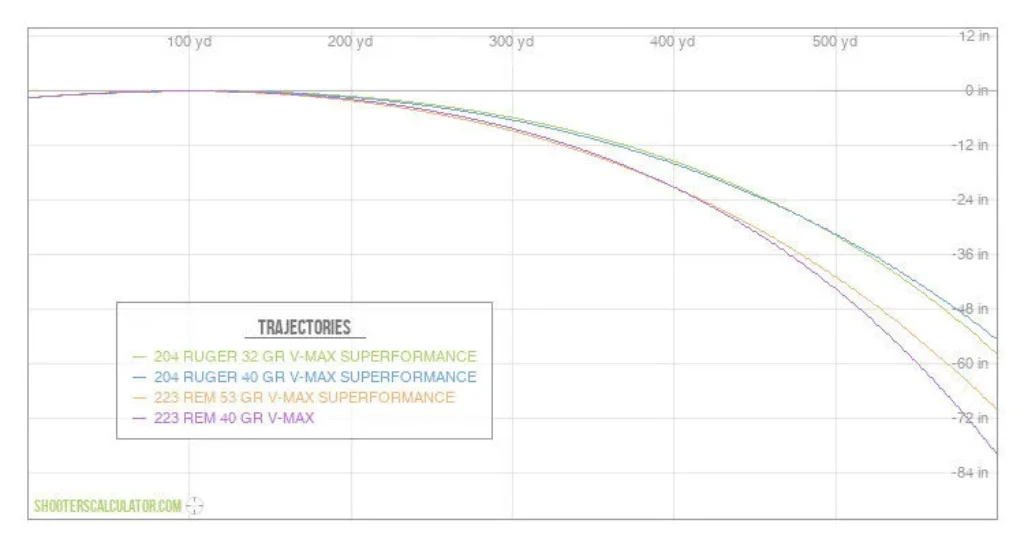
Accuracy Comparison: 223 vs 204 Ruger
When built on a quality rifle with a proper twist rate and loaded or tuned to the barrel, the .204 is capable of excellent accuracy and sub-MOA (Minute-of-Angle) performance in many rifles. That reputation is why varminters prize it.
That’s not to say a 223 can’t also be known to shoot sub-MOA in the right conditions, as well. Accuracy for a 223 round depends on a number of factors including the rifle quality, barrel twist rate, ammunition quality, load development, and shooter skill.
What is a sub-MOA: this is a term that defines a firearms capability to shoot a group of shots with a spread of less than one “Minute of Angle” or MOA.
Recommended Zero and Effective Range
Common sight-in strategies:
- 100-yard zero: simplest and works well for many shooters; .204 will be very flat inside these typical varmint ranges.
- 200–300-yard zero: used by some who regularly shoot in that distance band to minimize holdovers there.
Typical practical effective ranges:
- .204 Ruger: 200–400 yards for ethical, precise coyote shots for most shooters; skilled shooters and ideal conditions can extend that further but wind/light-bullet drift becomes the limiting factor.
- .223 Remington: Practical varmint/coyote work often falls in the 100–400 yard band depending on bullet weight; heavier .223 bullets hold energy/wind resistance better beyond 300 yards.
Ballistic Coefficients
What is a BC: BC, or Ballistic Coefficient, measures how well a bullet cuts through air. A higher BC = less drop, less wind drift, better retained velocity.
Typical ranges (approx., verify with your bullet maker):
- .204 Ruger: 0.12–0.23 (G1), very light bullets, lower BC but very high muzzle velocity.
- .223 Remington: 0.15–0.55+ (G1), wide spread and low for light varmint bullets, high for heavy match/hunting projectiles.
Overall, .204 trades BC for speed. .223 can use higher BC bullets for less wind drift and more retained energy at longer ranges. Chronograph your rifle and use the manufacturer’s BC in a ballistics solver for accurate drop and wind numbers.
Is the .204 Ruger a barrel burner?
The .204 Ruger is a very high-velocity “speed” cartridge and some shooters and threads report faster erosion if the rifle is abused with long rapid strings of hot shots.
Proper care, cooling between strings and occasional milder loads will extend your barrel life. Community discussions indicate it’s more sensitive than moderate-velocity cartridges, but real-life barrel life varies widely by shooter habits and barrel manufacture.
Which is better for coyotes: 223 vs 204 Ruger?
Both can be good choices. Like I’ve said througout this entire blog, it depends entirely on your use-case.
If you operate mostly on wide-open ground and value the flattest trajectory and minimal recoil for long precise shots, the .204 Ruger is a prime choice. If you need more energy, penetration, and more margin for hits in brush or closer engagements, the .223 Remington is more versatile and forgiving.
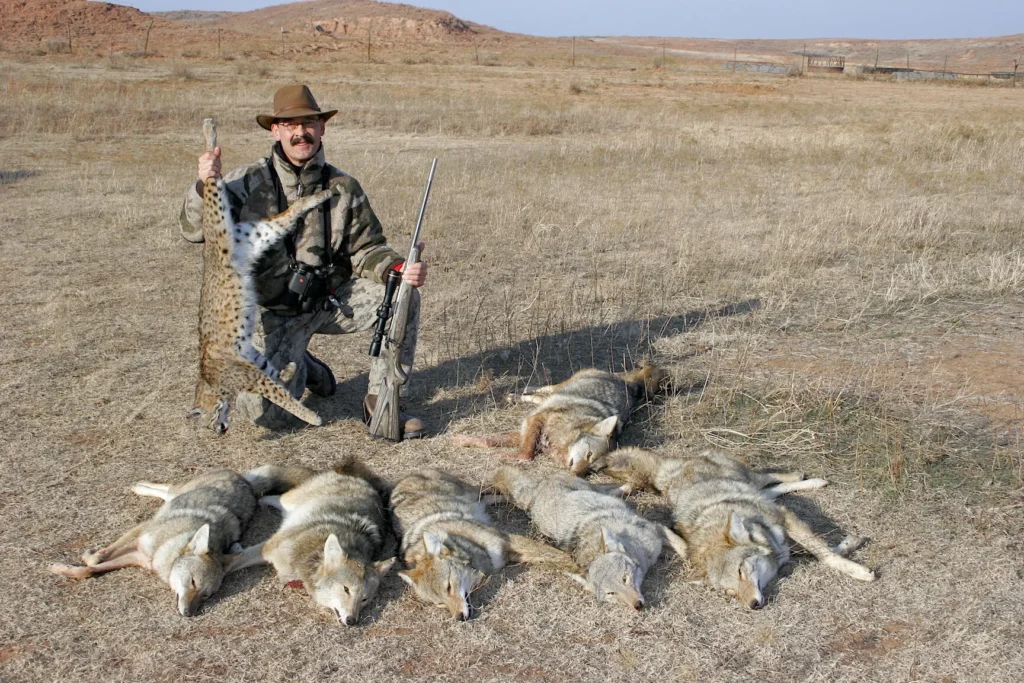
Practical Applications: Which Caliber for Which Job?
Let’s get into the nitty gritty of what I’ve been going on and on about: all the use cases that will determine which cartridge will do you justice.
| Use Case | .204 Ruger | .223 Remington |
|---|---|---|
| Home Defense | Definitely not intended for defense; very light, high-velocity bullets are built for varmints, not barriers or deep penetration. | Sometimes used in AR-15s with soft-point or barrier-blind loads, but still NOT PREFERABLE indoors. Know your backstops and local laws. |
| Training / Plinking | Ultra-low recoil and very accurate, but ammo is less common and pricier; not the cheapest way to train. | Excellent choice. Cheap, plentiful ammo and light recoil make it the go-to for high-volume range time. |
| Varmint / Predator | Outstanding. 32–40 gr bullets shoot very flat with minimal recoil; great for prairie dogs, ground squirrels, and coyotes in open country. | Very good and versatile. 40–55 gr varmint bullets work well on pests/coyotes, though trajectory isn’t as flat as .204. |
| Deer / Antelope | Not recommended; bullet weight/penetration are marginal for big-game ethics in most places. | Sometimes legal with 62–77 gr controlled-expansion bullets; still on the light side though, so check regulations and keep shots conservative. |
| Hogs | Not advised. Light varmint bullets lack penetration on tough hogs. | Borderline but workable on smaller hogs with bonded soft points/heavier bullets at sensible distances. Be smart about your use. |
| Elk / Black Bear | No, completely insufficient mass/penetration for ethical shots. | No, energy and penetration are inadequate; choose a larger caliber. |
| Competition / Precision | Superb bench/varmint-match accuracy; keep strings reasonable to preserve barrel life on hot loads. | Proven in Service Rifle/3-Gun/PRS gas-gun. Huge bullet/load range (69–77+ gr) and component availability. |
| New Shooters / Youth | Excellent choice. Virtually no recoil and a flat trajectory help new shooters build confidence. However, price point can deter | Also excellent; slightly more recoil than .204 but cheaper ammo makes practice easy. |
| Night Hunting / Thermal | Great for open-field coyotes, flat flight and light recoil keep follow-ups quick. | Strong choice with AR platforms and heavier bullets that buck wind better when it’s gusty. |
I will reiterate once again, pick a .204 Ruger round when you want the flattest trajectory and near-zero recoil for long varmint and coyote shots in open country. Choose .223 Remington when you want maximum versatility, cheaper practice ammo, and heavier bullet options that carry more energy and handle wind better.
Always check your states hunting regulations and guidelines. Do your own research and see how each caliber feels for you!
Pros and Cons of Each
| Pros | Cons | |
| .204 Ruger | Extremely flat-shooting and very high muzzle velocity. Very light recoil for precise follow-ups. Outstanding varmint terminal performance with the right bullets. | Light bullets mean less penetration margin on larger game. Shot placement is critical. Less common ammo/gun availability than .223; potentially higher ammo cost. Potential for faster throat erosion if abused. |
| .223 Remington | Extremely common, wide rifle & ammo availability. Better retained energy with heavier bullets, more versatile role. Many factory loads tuned for match, hunting, or tactical use. | Not as flat as .204 for the same zero. Some jurisdictions have game-size restrictions for using .223 on deer, check local game laws before hunting larger game. |
Buying Tips and Bulk Ammo Considerations
Availability & Price
Let’s be honest, the .204 Ruger is a specialty cartridge. You’ll find quality factory ammo from the major manufacturers (Hornady, Nosler, etc.), but choice and shelf depth aren’t nearly as broad as .223.
Expect seasonal ups and downs: varmint-season demand can tighten supply and nudge prices higher. For routine practice, .204 is usually pricier per round than common .223 match/varmint loads, so plan your range time accordingly.
If cost and easy resupply matter to you, factor that into your rifle and ammo decision. Many varminters keep a dedicated .204 rifle for precision work and use a cheap .223 rig for high-volume practice to save on ammo spend.
Barrel length
As previously discussed, published velocities for .204 loads are almost always measured from long test barrels (often 24″). In real-world hunting or compact rigs with 20″ or shorter barrels expect to see those lower muzzle velocities, commonly in the range of 100–150 fps less than the box numbers. That change affects trajectory, time of flight, and terminal performance, so don’t assume your rifle will match factory specs exactly.

When buying, decide whether you prioritize maximum velocity (go longer barrel) or maneuverability (shorter hunting barrel). Once you have a rifle, test a few factory loads and, if you handload, chronograph them in your rifle to determine the real-world speeds and pick the load that groups best and gives the trajectory you want.
PMC Bronze 223 Rem 55 Gr FMJ BT SKU: TSPMC223A
Speer Gold Dot LE Duty 223 Remington 55 Gr SP SKU: TS24446
Remington Premier 204 Ruger 32 Gr AccuTip-V SKU: TSPRA204A
Hornady Superformance Varmint Express 204 Ruger 40 Gr V-Max SKU: TS83206
FAQ’s
- What is the .204 Ruger comparable to?
- Ballistically it’s comparable to other high-velocity varmint cartridges (.22-250, .220 Swift family) and sits between tiny rimfires and the .223/5.56 family in role and speed.
- Is a .223 or .204 Ruger better for coyotes?
- Both are capable. Choose .204 for flat, long-range varmint work; choose .223 for more energy and versatility. Bullet selection and shot placement are the deciding factors.
- What is .204 Ruger good for?
- Varmint and predator hunting, bench and precision shooting where flat trajectory and low recoil are priorities.
- What’s the effective range of a .204 Ruger?
- Practically 200–400 yards for most shooters on coyotes and varmints. With exceptional shooter skills and primed conditions it can be used farther, but wind and light-bullet drift limit performance.
- What does a .204 drop at 400 yards?
- Exact drop varies by load and zero. Consult a load-specific trajectory table. Published Hornady & ballistics calculator tables show notably less drop than common 55 gr .223 loads at 400 yards.
- Is the .204 Ruger accurate?
- Yes, in well-built rifles and tuned loads it achieves very good group sizes.
- What is the flattest shooting caliber for coyotes?
- Among common, readily available cartridges, fast varmint rounds like the .204 Ruger, .22-250 and .220 Swift are among the flattest. The .204 is frequently recommended for coyote work on open ground.
- Is the .204 Ruger a barrel burner?
- It runs at very high velocities and can show faster throat wear if hot loads are fired rapidly. Moderation, proper cooling, and milder loads when possible extend the barrels life. However, not all rifles experience rapid failure like this.
- What’s the best distance to sight in a .204 Ruger?
- 100 yards is simple and common. Choose a 200–300 yard zero if that better matches your typical shooting distances. Use the specific load’s trajectory to pick the optimal zero.
- What is the effective range of a .204 Ruger on coyotes?
- 200–400 yards is a realistic, ethical window for many shooters. Beyond that, nothing is guaranteed. Wind and light-bullet drift can increase miss risk. Practice and proper bullet selection are essential.
Bulk-Buy and Deals
Whether you’ve settled on the .204 Ruger or the .223 Remington, Target Sports USA has the ammunition to feed your fire.
Additionally, for shooters prioritizing cost-effectiveness for high-volume shooting, bulk purchases with the AMMO+ membership offer significant savings. Check out our current deals and enjoy the convenience of ammunition shipped directly to your door.
Disclaimer: Always handle firearms responsibly and adhere to all local, state, and federal laws. The information provided is for educational purposes. Seek professional training from a qualified firearms instructor.
Check out our Instagram for updates on deals, giveaways, and more! We also have an X here.
Madalynn (Maddie) Giglio is a part of the creative team behind the brand marketing moves at Target Sports USA. With several years of experience across blog content, social media, and strategic marketing, she brings a seasoned eye to every campaign worked on, whether it’s collaborating hand in hand with top influencers like Tony Sentmanat (RealWorldTactical) or reppin’ the TSUSA brand at industry events like the Great American Outdoor Show (GAOS).
She has built a strong foundation in the firearms space by obtaining hands-on experience in the field, learning from industry pros, and hitting the range with friends and family. Her mix of first-hand experience and marketing instincts makes her a trusted voice and helps her craft content that speakers to serious shooters and new gun owners alike.
